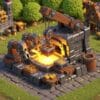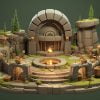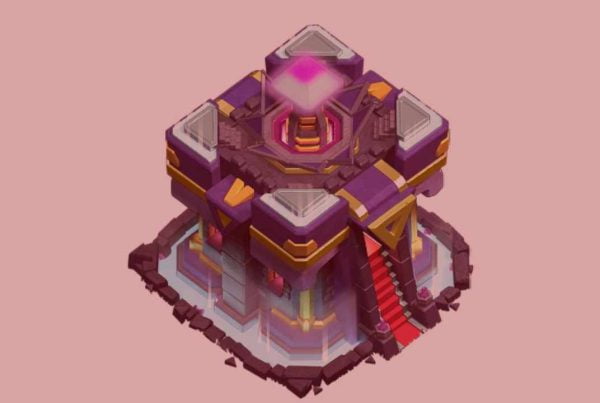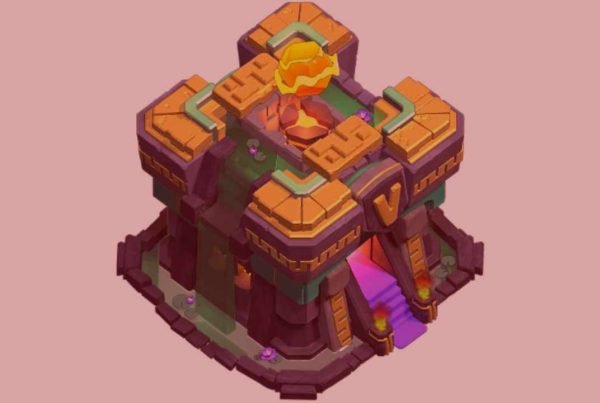Summary
The strategic positioning of walls is essential for designing a robust, well-defended settlement. As the primary line of defense, walls can withstand substantial damage from enemy attacks. However, their effectiveness diminishes if they do not fully enclose the structures they are meant to safeguard. Any gaps in the wall’s continuity render it ineffective, as enemy forces will simply pass through the breach.
An exception to this rule is the funneling tactic, where a player intentionally leaves a gap to group enemy troops together and subsequently eliminate them using the splash damage from defensive units such as Mortars or Wizard Towers. Alternatively (or additionally), one can catch intruders off-guard by placing traps like Bombs or Spring Traps within the openings.
Walls primarily obstruct ground units, with a few exceptions including Hog Riders, Miners, Headhunters, Yetimites, Grand Warden, Royal Champion, and all grounded Pets except the Mighty Yak. Air units like Balloons and Dragons can bypass walls entirely.

Numerous countermeasures exist against walls: Wall Breakers and Super Wall Breakers target walls upon deployment, inflicting 40x normal damage to walls but self-destructing in the process. Their explosions cause splash damage and can affect two layers of adjacent walls. The openings created by Wall Breakers allow ground units to access buildings within the walls, making them ideal for breaching walls.
Super Giant, Wall Wrecker, Stone Slammer, Log Launcher, and Mighty Yak can all inflict extra damage to walls, though none of them specifically target them.
Jump Spells temporarily allow ground troops to bypass walls, rendering them less effective, while four Earthquake Spells can demolish any walls within their area of effect.
Strategies
Defensive Strategy
The primary purpose of walls is to impede attacking ground (non-flying) troops, allowing defenses to damage and eliminate assailants as they attempt to breach the walls. Once openings are created, attackers can freely destroy defenses and other buildings within the walls. Therefore, when devising a defense, players should avoid enclosing their entire village within a single large wall. Instead, it is advisable to design walls in layers or compartments, forcing ground troops to break through multiple barriers to attack the entire village, while also providing defenses with more opportunities to repel the assault. It is inevitable that some buildings cannot be placed within the walls; this is normal and can even be advantageous by positioning non-defensive and non-resource buildings like Builder’s Huts, Army Camps, and the Laboratory just outside the walls, creating an additional layer for enemy troops to fight through.
Wall Breaker’s bombs inflict damage to everything within a small radius (area splash), so enclosing a compartment with grouped layers of walls is inadvisable.
Attacking Archers and Wizards can shoot over walls and attack structures behind them. Defenders can use less critical buildings as a “buffer,” delaying these ranged units’ attacks on more important structures. In this case, ensure that long-ranged defenses are within range and have ample opportunity to counterattack before these buffer buildings are completely destroyed and attackers advance to the wall.
The defensive territory in which an attacker cannot spawn troops is shown as a white overlay after any building has been moved. Attackers may be able to spawn troops behind walls if any gaps exist in this territory. Since every structure has an additional one-square perimeter around which troops cannot be spawned, avoid gaps larger than two squares to prevent this from happening. Traps, decorations, obstacles, and Hidden Teslas are exceptions and do not increase the defender’s territory.
On the other hand, such gaps can be filled with extra walls, isolating valuable buildings (such as Inferno Towers or the Town Hall) in a large compartment. Without proper funneling or access to the compartment, ground troops will often ignore these buildings.
An outdated practice is using single standing wall struts or spikes to lure Wall Breakers; however, this spiking tactic is no longer effective, as Wall Breakers now only target walls that consist of two or more consecutive segments. This technique can still be used to extend the defender’s territory, thereby increasing the outer perimeter where attackers may spawn troops.
Wall Breakers only target walls that fully or partially enclose buildings; they will ignore empty compartments and spikes (unless no other targets are available).
A common mistake among beginners is attempting to “close” wall gaps with buildings, obstacles, decorations, etc. This is ineffective; troops can walk right through the gap as though the obstacles were not there. Only continuous wall segments will deter ground troops. However, new attackers often make the same mistake and waste Wall Breakers on these gaps in the walls, which may work in your favor if you lack sufficient walls for your layout.
Another frequent error made by new players is trying to use the edges of the map as barriers, thinking this will allow them to construct walls on only two or three sides. This is also ineffective, as enemy troops can always be spawned on the darker grass area surrounding the village, even though the player cannot place buildings there.
Players should surround their Town Hall, defensive buildings, and (if desired) resource storages with walls rather than Army Camps, Barracks, Spell Factory, Laboratory, or Builder’s Huts, as damage to these buildings is relatively inconsequential. This is especially true if your Town Hall level is low and resources are limited.
Players can place traps between gaps in the walls; when enemy troops step on them, they will be easily killed by the traps.
Upgrading walls to higher levels is usually not worth the investment unless everything else is upgraded due to the numerous countermeasures available. However, when sufficiently upgraded, walls can still serve as an intimidation factor.
Offensive Strategy
Look for gaps or wall segments that are lower levels than others. Also, search for areas within walls where buildings have been poorly positioned. Be cautious, however, as gaps may be intentional and could contain Traps or Hidden Teslas. Utilize Wall Breakers effectively to penetrate walls quickly. If possible, attack walls that are out of the range of defenses.
Spiking is no longer effective, so decoys and distractions can be avoided.
Once a section of a wall is breached, Wall Breakers will ignore that section and attempt to find the next closest wall enclosing a building. This section may or may not be behind the breached section.
Four Earthquake Spells can destroy walls of any level.
By using air troops, Jump Spells, Hog Riders, Miners, Headhunters, the Grand Warden, and the Royal Champion, you can avoid the need to destroy walls.
| Town Hall Level | 1 | 2 | 3 | 4 | 5 | 6 | 7 | 8 | 9 | 10 |
|---|---|---|---|---|---|---|---|---|---|---|
| Number Available | 0 | 25 | 50 | 75 | 100 | 125 | 175 | 225 | 250 | 250 |
| Size |
|---|
| 1×1 |
| Level | Cost | Cumulative Cost | Hitpoints | Town Hall Level Required |
|---|---|---|---|---|
| 1 | 200 | 200 | 300 | 2 |
| 2 | 1,000 | 1,200 | 500 | 2 |
| 3 | 5,000 | 6,200 | 700 | 3 |
| 4 | 10,000 | 16,200 | 900 | 4 |
| 5 | 30,000 | 46,200 | 1,400 | 5 |
| 6 | 75,000 | 121,200 | 2,000 | 6 |
| 7 | 200,000 | 321,200 | 2,500 | 7 |
| 8 | 500,000 | 821,200 | 3,000 | 8 |
| 9 | 1,000,000 | 1,821,200 | 4,000 | 9 |
| 10 | 3,000,000 | 4,821,200 | 5,500 | 9 |
| 11 | 4,000,000 | 8,821,200 | 7,000 | 10 |





